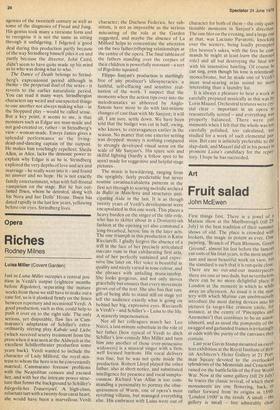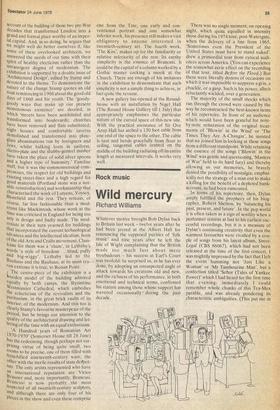Art
Fruit salad
John McEwen
First things first. There is a jewel of a Matisse show at the Marlborough (till 29 July) in the best tradition of their summer shows of old. The place is crowded with lookers, the magic as potent as ever. One painting, 'Branch of Plu:n Blossom, Green Ground', almost his last before the famous
cut-outs of his final years, is the most impor' tant and most beautiful work on view, but the standard is such that it is run quite close. There are no out-and-out masterpieces, there are one or two duds, but nevertheles.s, there can be no more delightful place lit London at the moment in which to while away an afternoon. As usual it is the mas' tery with which Matisse can unobtrusivelY introduce the most daring devices into his pictures (a target-like crimson circle, for, instance, at the centre of 'Pineapples and Anemones') that continues to bean astonishmerit, and as usual the pomposity of the swagged and garlanded frames is irritatinglY at odds with the purity of the canvases theY contain. Last year Gavin Stamp mounted an excel' lent exhibition at the Royal Institute of British Architects's Heinz Gallery at 21 Portman Square 'devoted to the overlooked splendours of the Memorials and Cemeteries raised on the battlefields of the First world War. Now at the same gallery (till 29 July) he traces the classic revival, of which these monuments are one flowering, back, or rather forward from its origins in 1890' `London 1900' is the result. A small — the gallery is small — but admirably clear account of the building of those two pre-War decades that transformed London into a grand and formal place worthy of an imperial capital. And, in so doing, he argues that we might well do better ourselves if, like some of these overlooked architects, we answered the needs of our time with their spirit of healthy electicism rather than the .intransigent dogma of modernism. The exhibition is supported by a double issue of 'Architectural Design', edited by Stamp and devoted to the theme. To demonstrate the nature of the change Stamp quotes an old roue reminiscing in 1908 about the good old days of 1860 and his youth. The 'goodygoody ways that make up our present monotonous existence' are decried, in Which 'Streets have been annihilated and transformed into boulevards; churches have been removed and flats substituted; night houses and comfortable taverns demolished and transformed into plateglass abominations run by foreigners and Jews, whilst hulking louts in uniform, electroplate and the shabby-genteel masher' have taken the place of solid silver spoons and a higher type of humanity.' Familiar stuff, but it was the commonsensical comPromises, the respect for old buildings and existing street-lines and a high regard for good materials (Portland stone was a notable reintroduction) and workmanship that characterised the work of Lutyens, Voysey, alomfield and the rest. They remain,, of course, far less fashionable than a modernist like Mackintosh, whose work at the time was criticised in England for being too arty in design and badly made. The modernists in their turn yearned for buildings that incorporated the current technological advances and the intellectual idealism, born of the old Arts and Crafts movement. Classicism for them was a 'sham', in Lethaby's Words 'a style of boredom . . .blind, puffy and big-wiggy'. Lethaby led to the Bauhaus and the Bauhaus, at its most craven extreme it is true, to Ronan Point.
The centre-piece of the exhibition is a wooden model of the building admired equally by both camps, the Byzantine Westminster Cathedral, which embodies the eclecticism of the revivalists and the Puritanism, in the great brick vaults of its interior, of the modernists. And this too is Clearly Stamp's favourite masterpeice of the Period, but he brings our attention to the quality of the architectural drawing and lettering of the time with an equal enthusiasm.
'A Hundred years of Romanian Art 1870-1970' (Somerset House till 28 June) has the redeeming, though perhaps not surPrising virtue of being quite small, two rooms to be precise, one of them filled with frenchified nineteenth-century ware, the other with the sterile results of state depotism. The only artists represented who have an international reputation are Victor. Brauner and, more importantly, Brancusi. Br ancusi is now probably the most resPected of all twentieth-century sculptors, and although there are only four of his Pieces in the show and even these comprise
one from the Tate, one early and conventional portrait and one somewhat inferior work, his presence still makes a visit obligatory to anyone interested in twentieth-century art. The fourth work, 'The Kiss', makes up for the familiarity or relative inferiority of the rest. Its earthy simplicity is the essence of Brancusi. It could be the capital of a column worked by a Gothic master cocking a snook at the Church. There are enough of his imitators in the exhibition to demonstrate that such simplicity is not a simple thing to achieve, in fact quite the reverse.
A new gallery has opened at the Roundhouse with an installation by Nigel Hall (The Round House Gallery till 1 July) that appropriately emphasises the particular nature of the curved space of this new site. With the practical assistance of Sir Ove Amp Hall has arched a 130 foot cable from one end of the space to the other. The cable is taut and bends gracefully from floor to ceiling, tangential cables centred on the middle of the building radiating off its entire length at measured intervals. It works very well.















































 Previous page
Previous page